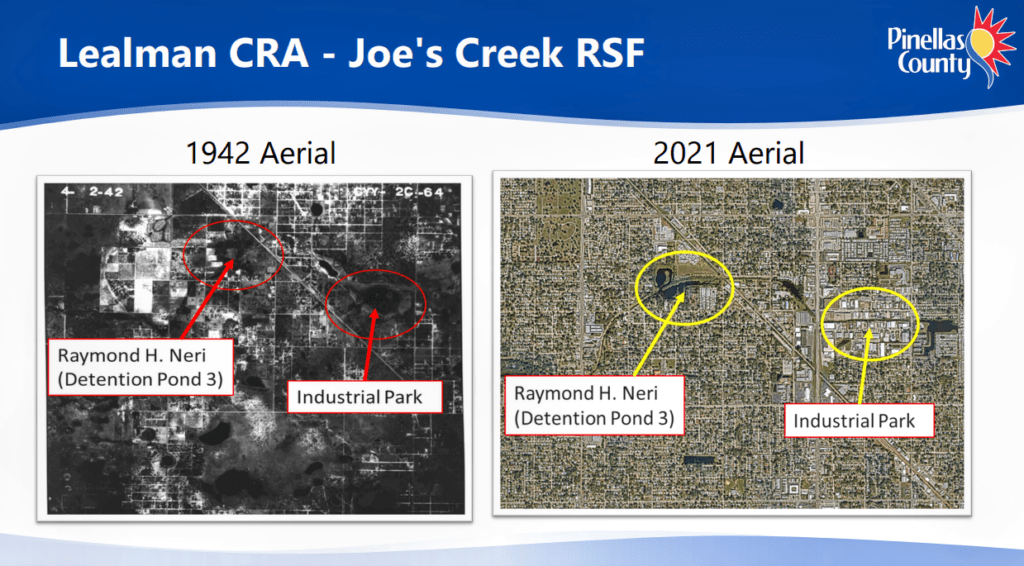County incentivizes development through stormwater facilities
Pinellas County is now using its regional stormwater collection facilities to spur redevelopment in what it considers priority areas, including unincorporated Lealman.
During Thursday’s work session, Pinellas commissioners heard an update on how the county will offer development credits and stormwater treatment solutions to lure new projects. Kelli Hammer Levy, director of public works, began the presentation by calling the initiative a relatively new concept.
Pinellas officials are applying the concept to three priority locations – Lealman, downtown Palm Harbor and most recently, the Gateway area around the St. Pete-Clearwater International Airport.
“There’s a real financial benefit to having a regional stormwater facility (RSF),” said County Administrator Barry Burton.
The county has recently focused a significant amount of time and money on improving Lealman, which sits about six miles northeast of downtown St. Petersburg. Levy began the discussion by explaining the latest redevelopment efforts in the traditionally low-income and underserved Community Redevelopment Area (CRA).
Lealman features two watersheds. To the north is Sawgrass Lake, which Levy explained drains into Tampa Bay. To the south is Joe’s Creek, and that water winds through St. Petersburg before ending in Cross Bayou and Boca Ciega Bay.
According to county documents, the area around Sawgrass Lake and Haynsworth RSF has widespread short to mid-term development opportunities and underutilized parcels. The Joe’s Creek watershed is more built-out.

A map showing potential development areas around Lealman’s two watersheds.
In partnership with the Southwest Florida Water Management District (SWFWMD), the county constructed Haynsworth RSF in 1997 to provide treatment for government projects. Levy said it was permitted to accommodate nearly 123 acres of impervious development, and 97.38 acres of “credit” remain available.
“Swift Mud (SWFWMD) is supportive of this concept to utilize this facility to help benefit the Lealman CRA and redevelopment opportunities there,” said Levy. “This one is pretty much ready to go.”
Levy noted a wide swath of land around Sawgrass Lake available for developers that want to utilize the facility for treatment credits. She added it is not mandatory and builders could still use onsite solutions, but called the process another tool in the toolbox to help projects move forward.
The county, said Levy, has already begun determining how it would apply the initiative and established accounts to process payments.
Levy explained that program officials developed a policy using standard calculation methodology employed by other local governments. The development credit cost to the county is $18,517 per impervious acre, and the facility would provide most of the required nutrient removal for redevelopment.
Utilizing the facility to meet stormwater needs, said Levy, allows developers to use space for other purposes.
“Some of the developments wouldn’t occur if they had to provide onsite – it’s just such tight, small property or lots,” said Commissioner Dave Eggers. “So, a good tool.”
Levy added that one of the challenges of the Lealman CRA is that it is so developed, and taking advantage of existing facilities is “really great for the community.”
The county would like to provide the same incentives around Joe’s Creek, said Levy, but noted significant flooding problems in the area.
She pointed to a map from 1942 showing the Raymond H. Neri detention pond and a wetland area. “At some point in time,” a developer built an industrial park over the wetlands, said Levy, creating a “very challenging situation.”

A map showing where an industrial park was built over wetlands in Lealman.
While Levy was unsure when the industrial park opened, Commission Chair Charlie Justice noted it was there his entire life, and now contains a mix of traditional warehouse structures and some reconfigured for modern use.
In an effort to decrease flooding and spur redevelopment, the county is undergoing a $51 million Joe’s Creek Greenway project. Levy noted the project received a $17 million grant from the Florida Department of Economic Opportunity to aid in the transformative reimaging of the creek, including channel improvements, floodplain restoration and structure upgrades to enhance flow capacity.
“Is it going to completely resolve the issues that we’re having?” asked Levey rhetorically. “No, it is not. We do need additional storage; we need additional floodplain restoration.”
Levy said a traditional stormwater facility to meet the needs around Joe’s Creek would require nearly 40 acres, an impossibility in the highly urbanized community. To mitigate the lack of space, Levy said county officials are discussing using an ALUM (aluminum sulfate) system.
The county currently operates six such facilities, which provide significant nutrient load reductions through a much smaller footprint. Levy said a similar system in Pinellas using a 1.5-acre pond over a 2.5-acre space treats stormwater runoff from a 98-acre area.
“So, we really feel like this might be a better fit for the Joe’s Creek CRA treatment option,” said Levy. “Just given the challenges of ‘location-location-location’ and the size of the property that we could use.”
The county’s next steps for adding a Joe’s Creek RSF include deciding whether to use a traditional pond or ALUM system, site selection and acquisition for the facility and implementing a development credit system.
As with the Haynsworth RSF, Levy said the county would not mandate that developers use the facility. Instead, they will explain the benefits and allow projects to keep the stormwater onsite if they choose.
“So, when you’re considering your design, if this is more economical for you, if this is better for your business plan, it’s a tool for you to use,” she said.







